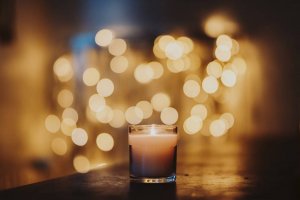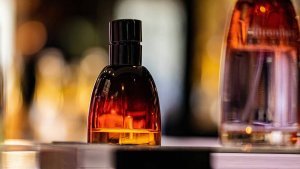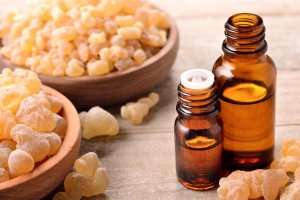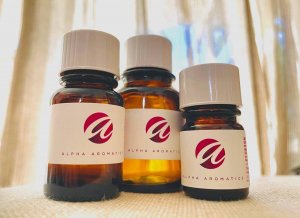Balsamic notes are highly regarded within the realm of fine perfume, and they are known for their soothing, soft, warm and sensual character.
The raw materials that comprise these notes have a rich and colorful past dating back to the ancient world.
The name can be somewhat confusing because they have nothing at all to do with vinegar. The term derives from the Latin word, balsamum, which translates to fragrant balm, and refers to the residue found in the barrels in which the vinegar is stored.
This naturally secreted substance is at first in liquid form, but then it dries and hardens when it comes in contact with the air and releases a potent odor.
Balms and resins are raw materials that are collectively known as balsamic notes. They are most often found in the ambery family of fragrances formulated by perfume masters.

These naturally forming compounds are known to complement vanilla and render a mysterious nuance to any fragrance. This sweet fragrance accord is dense, inviting, woody nuanced, resinous and powerful.
Collecting the balsam involves cutting the trunk and collecting the sap. Distillation methods vary depending on the specific source of the raw material.
In the case of water distillation, the substance is submerged entirely in water, which is then boiled via direct fire, open or closed steam jacket or open or closed steam coil.
This last process is popular because it involves direct contact between the boiling water and raw material.
Obtaining either balsamic essence or absolute, can be achieved via steam or volatile solvents.

What Are Balsamic Notes In Perfume?
The most frequently used balms and resins in perfumery are benzoin, Cistus Labdanum, Incense, myrrh, Peru balsam, Styrax, Tolu Balsam and Copahu balsam. More on each follows below.
Benzoin
Native to Siam (Thailand) and Sumatra and derived from styrax benzoin, Siamese benzoin is the most valued by perfumers, and it is the rarest of the two, which explains its prohibitive cost. It is a deeply vanilla-toned facet.
There are two types of Sumatra benzoin, one of which is used in fumigation and dyeing, and the other exclusively for extracting benzoic acid.
Cistus Labdanum
Deep and leathery in character, this balsamic ingredient is derived from the rockrose bush and harvested from the hairs of the goats left behind after grazing on the bush.
These soothing, rich notes are often found in the ambery, chypre and floral families of fragrance.
Incense
Derived from the Boswellia tree that is native to the mountains of East Maya in South America and Africa, the grey bark on its trunk is easily peeled. Used for centuries in sacred rituals by many civilizations, it is equally important in perfumery.
The gum is collected from the bark of the tree and steam distilled. The resulting essence is dark, potent and aromatic, marked by smoky aspects.
Myrrh
Dating back to biblical times and the kingdom of ancient Greece and its sacred mythology, there are more than 100 species of myrrh (Commiphora), but only three that are used in perfumery (Commiphora Nees, Abyssinia and Schimperi).
Myrrh consists of 60% gum, 30% resin and essence plus a bitter facet. Considered one of the world’s most exquisite and precious perfume ingredient, its olfactory profile is incense and licorice nuanced, woody and slightly fruity.
Peru Balsam
Peru Balsam comes from a tree that is indigenous to El Salvador, and not Peru as one might expect. Its name derives from the fact that this tree became particularly invasive there.
It is found in many cosmetic products, candles, cough syrups and perfumes. Its olfactory profile is sweet with touches of lush vanilla, warm inviting cinnamon and the slightest nuance of earthy, bitter aspects.
Styrax
Styrax balsam derives naturally from two species of trees, which are found in Syria, Asia Minor and Africa.
This liquid raw material is comprised of resin, a substance called styrol, cinnamic acid and styracine. Its odor profile is intensely vanilla, floral, leathery, rich and milky.
Tolu Balsam
This raw material comes from Columbia. Its olfactory profile is a fragrant cloud of cozy cinnamon, elegant and sugary vanilla and creamy, dazzling floral facets.
As part of a dry down, this note is long lasting and seamlessly blends with almost any fragrance.
Copahu Balm
This tropical tree, with its small, white, woody and sweet smelling flowers, is known to reach heights of up to 100 feet.
Its fragrant resin accumulates within the cavity of the tree trunk and is extracted by incisions. Popular in perfumes and scented lotions and soaps, it is also an agent that restores faded color in old paintings.
How Are They Used In Perfumery?
Balsamic notes are potent and tenacious, and they serve as excellent fixatives in both masculine and feminine fragrances.
They can be recreated with many diverse ingredients. Myrrh, and frankincense for example, are two gum resins with intensely woody, fruity and earthy elements.

Most often found in the heart or base notes of perfumes, they are known to greatly complement floral and vanilla aspects.
Their whisper of gourmand nuances add a subtle, sensual and exotic dimension to any fragrance.
Our Use Of Balsamic Notes In Formulations
We’ve been a leading perfume manufacturer and purveyor of fine fragrances for decades, and our clients hail from every corner of the globe.
Consumer satisfaction lies at the core of their stellar customer service and their mission“to build great scents that build great brands” has remained unchanged since its inception, eight decades ago.
The following represent five of the most popular fragrances utilizing balsamic notes.

Dark Labdanum Patchouli
The head notes of this glorious fragrance stream with citrus facets of energizing grapefruit, fresh, clean lemon and sharp lime zest.
These elements soon drift into a heart note bouquet marked by facets of intoxicating jasmine, tinges of cinnamon, soft, intimate and lush tonka bean and spicy, bright and sugary lily.
This compelling fragrance completes with a dry down featuring, dark, sensual patchouli, robust, deep and leathery labdanum, smooth, creamy sandalwood, earthy, erotic musk, lush, elegant vanilla and warm, inviting honeyed amber.
Galbanum Bloom
Head notes of sweet, dark and berry-like cassis, luscious orange and fresh, clean lemon drift seamlessly into a floral heart note bouquet marked by aspects of rich, haunting jasmine, powdery, vanilla-nuanced heliotrope, creamy, potent and waxy tuberose, honeyed, radiantly sweet and spicy freesia and wild, warm honeysuckle.
A dry down of intense, green, woody and balsamic galbanum and piquant, hot and fruity clove leaf completes this intriguing scent.
Labdanum Tuberose
This fruity/floral blend opens with head notes featuring facets of honeyed, lush mandarin, sweet, spicy strawberry, and fresh, crunchy juniper berry.
These elements soon fade into an enchanting middle note formed by dusty, woody violet, rich, haunting jasmine, herbaceous, acrid and light neroli, creamy tuberose and sweet, narcotic yiang yiang.
This fragrance finishes with a dry down featuring warm, dark amber, sugary, floral cocoa, deep, dry and ambergris-nuanced labdanum and lush, noble vanilla.
Labdanum Orchid
Energizing and robust, this scent opens with top notes brimming with juicy orange, rich, sugary black coconut and tart red berry.
A floral heart note soon takes hold marked by smooth, creamy gardenia, powdery, floral orchid, bitter neroli and intense and intoxicating jasmine.
Base notes of sensual, erotic musk, rich, musky labdanum, creamy sandalwood, and enticing, luxurious vanilla finish this unforgettable fragrance.
Winter Fir And Balsam
A fragrance designed for the colder months of the year, this unforgettable scent evokes memories of the holiday season with its bright melange of vivid aromas .
These includes: warm, inviting cinnamon, woody, refreshing pine, woody fir, nutmeg-nuanced roasting chestnuts, earthy, spicy, firewood, and fresh apple pie.
Head notes stream with facets of slightly smoky essence of cypress, clean, balsamic pine and sweet, green and crisp apple.
A heart note soon seamlessly follows featuring green, dry fir balsam, minty, pungent eucalyptus herbs and salty, ozonic aquatic breeze.
A dry down of tangy, woody raspberry and sweet crystal sugar finishes this olfactory adventure.
In Conclusion
If your product or product lines needs a fresh coat of paint, so to speak, consider speaking with our master perfumers today and discover how any number of balsamic notes can help redefine your brand and olfactory message.
Photo Credits: Pixabay
 alpha aromatics®
alpha aromatics®